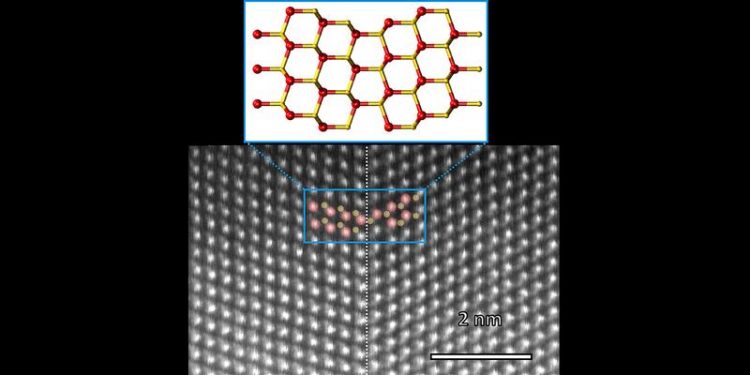Better thermal conductivity by adjusting the arrangement of atoms

Two layers of gallium phosphide periodically rotated against each other by 60 degrees. Department of Physics, University of Basel
In the electronics and computer industry, components are becoming ever smaller and more powerful. However, there are problems with the heat generation. It is therefore important to closely examine the heat carrier waves, known as phonons, and to understand their behavior in materials.
Research is now even going one step further and is specifically designing materials that can be used to control the propagation of phonons. One aim is to produce materials that release heat very quickly and thus heat up as little as possible. Another is to maintain temperature differences for as long as possible in order to use them for power generation.
Improved propagation using rotation
Headed by Professor Ilaria Zardo, the group from the University of Basel’s Department of Physics and the Swiss Nanoscience Institute examined materials that have tailored properties for the transmission and dispersion of phonons.
As part of an international collaboration led by Zardo, the nanoscientists were able to show for the first time that the arrangement of the atoms alone influences the phonons and thus the thermal conductivity.
To this end, the researchers produced gallium phosphide nanowires in which successive crystal layers are periodically rotated against each other by 60 degrees. This arrangement forms a superstructure in which phonons propagate coherently – thus conducting the heat very effectively.
Interfaces without defects
Previously, such superstructures were produced from periodically arranged layers of different materials. However, the interfaces between different materials are often not perfectly defined, and defects occur that massively reduce the propagation of phonons and thus the thermal conductivity.
In their recent investigations, the researchers proved that such interference effects do not occur if the material of the layers is identical but the arrangement of the atoms differs. And although the layers consist of the same material, the phononic properties only change through the rotation of the layers against each other. Until now it was not clear whether these novel systems behave like conventional superlattices.
The study is a collaboration between the Department of Physics at the University of Basel, the Swiss Nanoscience Institute (SNI), the Eindhoven University of Technology, the Autonomous University of Barcelona and the Institut de Ciència de Materials de Barcelona.
Prof. Dr. Ilaria Zardo, Departement Physik, Universität Basel, Tel. +41 61 207 37 34, E-Mail: ilaria.zardo@unibas.ch
Marta De Luca, Claudia Fasolato, Marcel A. Verheijen, Yizhen Ren, Milo Y. Swinkels, Sebastian Kölling, Erik, P. A. M. Bakkers, Riccardo Rurali, Xavier Cartoixà, Ilaria Zardo
Phonon Engineering in Twinning Superlattice Nanowires
Nano Letters (2019), doi: 10.1021/acs.nanolett.9b01775
https://www.unibas.ch/en/News-Events/News/Uni-Research/Better-thermal-conductivi…
Media Contact
All latest news from the category: Physics and Astronomy
This area deals with the fundamental laws and building blocks of nature and how they interact, the properties and the behavior of matter, and research into space and time and their structures.
innovations-report provides in-depth reports and articles on subjects such as astrophysics, laser technologies, nuclear, quantum, particle and solid-state physics, nanotechnologies, planetary research and findings (Mars, Venus) and developments related to the Hubble Telescope.
Newest articles

NASA: Mystery of life’s handedness deepens
The mystery of why life uses molecules with specific orientations has deepened with a NASA-funded discovery that RNA — a key molecule thought to have potentially held the instructions for…

What are the effects of historic lithium mining on water quality?
Study reveals low levels of common contaminants but high levels of other elements in waters associated with an abandoned lithium mine. Lithium ore and mining waste from a historic lithium…

Quantum-inspired design boosts efficiency of heat-to-electricity conversion
Rice engineers take unconventional route to improving thermophotovoltaic systems. Researchers at Rice University have found a new way to improve a key element of thermophotovoltaic (TPV) systems, which convert heat…



